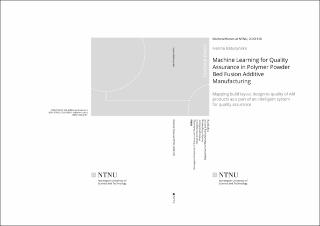| dc.description.abstract | The latest developments in the field of additive manufacturing (AM) have led to the wider use of this technology for the production of end-user products. As a result, more stringent requirements are set to the quality of parts produced with AM technology. In order to satisfy the needs of industries and to make additive manufacturing more attractive technology, a more in-depth understanding of the factors that cause variations is needed.
Since each AM process works with a limited number of materials and requires optimization of different process parameters, each AM category defines a variety of materials and parameters that can be optimized. There are seven different categories of AM, while a polymer powder bed fusion process is analysed in this work. Typically, the main components of the AM process, which are material, process, and CAD models(s), are investigated isolated from each other, or by limited combinations. However, a comprehensive mathematical description of any AM process should be based on all related components. Therefore, a new approach towards quality assurance in AM is needed.
This thesis aims at describing two perspectives: (1) gaining more knowledge about the effect of build layout design on the quality of the produced parts; (2) and how the obtained knowledge can be transformed into a user-friendly decision support tool to minimize variations in polymer powder bed fusion process prior to fabrication. The STL model characteristics, nine coordinates, three orientation angles, building platform utilization, platform density, material, run number, and build height are the parameters used to describe the build layout design.
As a result, experimental work on the EOS P395 AM system has been conducted, and 1526 standard dogbones specimens have been produced. In order to collect data from these specimens in a systematic way, a new data acquisition and analysis approach has been proposed, which includes data registration rules for stages before, during, and after the AM process. With the help of model-based system engineering, a number of calculation modules have been grouped into an intelligent system for quality assurance. Each calculation module consists of a set of functional requirements and a number of selected predictive models trained from the collected data using machine learning algorithms. Since the quality of machine learning models can be affected by the quality of used data, the data analysis pipeline has been proposed as a process of data preparation and has been developed based on the data science foundations. Data cleaning, data integration, data normalization, and feature selection have been used as the main data preprocessing steps. The resulting predictive models are:
•the Random Forest machine learning model with an accuracy of 99.16\% for the estimation of geometric deviations.
•the Random Forest machine learning model with accuracy 47.14\% (RMSE = 0.026) for estimation of compensation ratios in x, y, and z axes for each object individually.
•the Random Forest machine learning model with accuracy 66.24\% for estimation of tensile modulus, tensile strength, and strain at break.
This work also describes an attempt that was made to develop the predictive model for optimization of part location in the build chamber with respect to mechanical properties. However, this model requires further work. | en_US |
